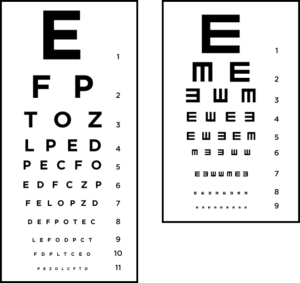Do you know what the term “legal blindness” really means? Legally Blind is a legal term used to define blindness as it pertains to being able to qualify for benefits.
Legal blindness is a level of visual impairment that has been defined by law either to limit allowed activities (such as driving) for safety reasons or to determine eligibility for government-funded disability benefits in the form of educational, service, or monetary assistance.
To be considered legally blind, your visual acuity must be 20/200 or worse in your better eye while you are wearing corrective lenses.
The United States Social Security Administration (SSA) defines legal blindness as follows:
Reduced central visual acuity of 20/200 or less in your better eye with use of the best eyeglass lens to correct your eyesight; or, Limitation of your field of view such that the widest diameter of the visual field in your better eye subtends an angle no greater than 20 degrees.
Legally Blind due to Reduced Central Visual Acuity
What does being legally blind due to “reduced central visual acuity of 20/200 or less” mean?
In the United States, clarity of eyesight almost always is expressed by a measurement system called Snellen visual acuity.
In this system, you identify smaller and smaller letters on an eye chart, and the results are expressed as a fraction standardized for a viewing distance of 20 feet.

(Picture of the Snellen Eye Chart)
If you have 20/20 Snellen visual acuity, this means the smallest letters you can discern from a distance of 20 feet (the first number in the fraction) are the same size as the smallest letters a person with historically defined “normal vision” can see at a distance of 20 feet (the second number in the fraction).
But if you have 20/200 visual acuity, the smallest letters you can identify from a distance of 20 feet are the size of the smallest letters a person with historically defined “normal vision” can see from a much greater distance — 200 feet, in this case.
So your central vision — the part of your eyesight you use to see and identify objects you are looking directly at — is much worse (10 times worse, in fact) than that of a normally sighted person.
Important: In order for you to be considered legally blind, your visual acuity must be 20/200 or worse in your better eye while you are wearing corrective lenses. So how poorly you see without your glasses or contact lenses when you get out of bed in the morning has nothing to do with it.
As long as your vision can be corrected to better than 20/200 with glasses or contacts, you are not considered legally blind, no matter how much nearsightedness, farsightedness or astigmatism you have.
Also, if your best corrected vision in one eye is worse than 20/200, but you can see better than 20/200 with corrective lenses with your other eye, you are not considered legally blind.
Legally Blind Due To Visual Field Restriction
Visual acuity tests measure the clarity of your central vision. However, some people can see small letters on an eye chart, but can’t see the person standing right next to them due to poor peripheral vision.
The importance of a wide visual field is especially apparent when you consider how much you rely on peripheral vision for certain activities, such as driving a car or crossing a busy street.
Visual field tests are totally different from tests of central visual acuity. Whatever device your eye doctor uses to test your peripheral vision, the goal is to determine if you have a normal field of view without unusual narrowing of your peripheral vision or the presence of abnormal blind spots.
People with normal peripheral vision have a maximum lateral field of view that creates an angle of nearly 180 degrees. In other words, distant objects that are located directly to the right or left of the observer are still visible. The normal vertical field of view of humans is not as expansive — it creates an angle of about 135 degrees. (Objects directly above us and at our feet are not simultaneously visible.)
If visual field testing reveals your peripheral vision is severely restricted to only 20 degrees (creating a very limited field of view often called tunnel vision), you are considered legally blind — even if you can see the 20/20 line on an eye chart.
How Many People Are Legally Blind?
According to a 2009 report by the National Federation of the Blind, 1.3 million people in the United States were legally blind at the time of the report.
In a 2004 study conducted by the Eye Diseases Prevalence Research Group, nearly one million (937,000) people over age 40 in the United States were legally blind, and another 2.4 million Americans had low vision (corrected visual acuity worse than 20/40 in their better eye).
The study authors estimated the number of legally blind Americans would increase by 70 percent to 1.6 million by 2020, with a similar rise in the number of people with low vision, due largely to the aging of the U.S. population.
Contact Social Security if you want to know more about disability benefits at www.ssa.gov
